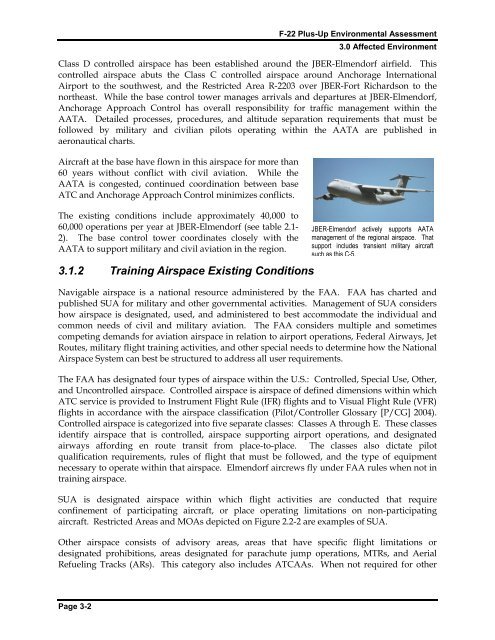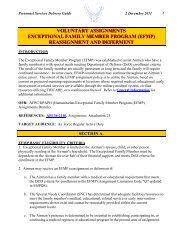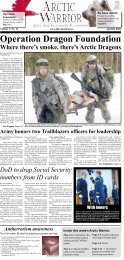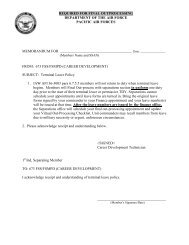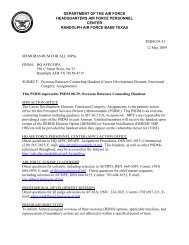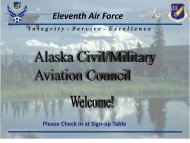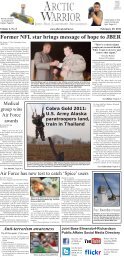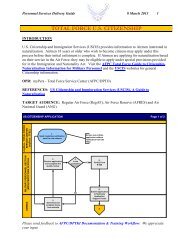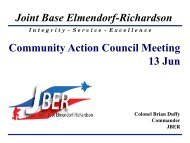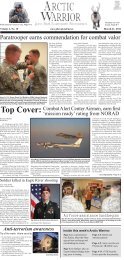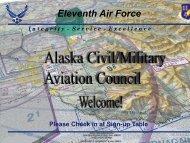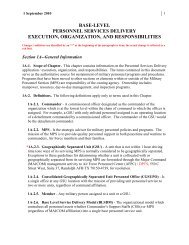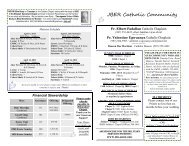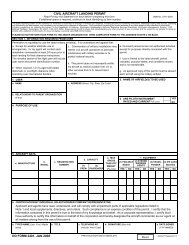F-22 Plus-Up Environmental Assessment - Joint Base Elmendorf ...
F-22 Plus-Up Environmental Assessment - Joint Base Elmendorf ...
F-22 Plus-Up Environmental Assessment - Joint Base Elmendorf ...
Create successful ePaper yourself
Turn your PDF publications into a flip-book with our unique Google optimized e-Paper software.
F-<strong>22</strong> <strong>Plus</strong>-<strong>Up</strong> <strong>Environmental</strong> <strong>Assessment</strong><br />
3.0 Affected Environment<br />
Class D controlled airspace has been established around the JBER-<strong>Elmendorf</strong> airfield. This<br />
controlled airspace abuts the Class C controlled airspace around Anchorage International<br />
Airport to the southwest, and the Restricted Area R-<strong>22</strong>03 over JBER-Fort Richardson to the<br />
northeast. While the base control tower manages arrivals and departures at JBER-<strong>Elmendorf</strong>,<br />
Anchorage Approach Control has overall responsibility for traffic management within the<br />
AATA. Detailed processes, procedures, and altitude separation requirements that must be<br />
followed by military and civilian pilots operating within the AATA are published in<br />
aeronautical charts.<br />
Aircraft at the base have flown in this airspace for more than<br />
60 years without conflict with civil aviation. While the<br />
AATA is congested, continued coordination between base<br />
ATC and Anchorage Approach Control minimizes conflicts.<br />
The existing conditions include approximately 40,000 to<br />
60,000 operations per year at JBER-<strong>Elmendorf</strong> (see table 2.1-<br />
2). The base control tower coordinates closely with the<br />
AATA to support military and civil aviation in the region.<br />
3.1.2 Training Airspace Existing Conditions<br />
JBER-<strong>Elmendorf</strong> actively supports AATA<br />
management of the regional airspace. That<br />
support includes transient military aircraft<br />
such as this C-5.<br />
Navigable airspace is a national resource administered by the FAA. FAA has charted and<br />
published SUA for military and other governmental activities. Management of SUA considers<br />
how airspace is designated, used, and administered to best accommodate the individual and<br />
common needs of civil and military aviation. The FAA considers multiple and sometimes<br />
competing demands for aviation airspace in relation to airport operations, Federal Airways, Jet<br />
Routes, military flight training activities, and other special needs to determine how the National<br />
Airspace System can best be structured to address all user requirements.<br />
The FAA has designated four types of airspace within the U.S.: Controlled, Special Use, Other,<br />
and Uncontrolled airspace. Controlled airspace is airspace of defined dimensions within which<br />
ATC service is provided to Instrument Flight Rule (IFR) flights and to Visual Flight Rule (VFR)<br />
flights in accordance with the airspace classification (Pilot/Controller Glossary [P/CG] 2004).<br />
Controlled airspace is categorized into five separate classes: Classes A through E. These classes<br />
identify airspace that is controlled, airspace supporting airport operations, and designated<br />
airways affording en route transit from place-to-place. The classes also dictate pilot<br />
qualification requirements, rules of flight that must be followed, and the type of equipment<br />
necessary to operate within that airspace. <strong>Elmendorf</strong> aircrews fly under FAA rules when not in<br />
training airspace.<br />
SUA is designated airspace within which flight activities are conducted that require<br />
confinement of participating aircraft, or place operating limitations on non-participating<br />
aircraft. Restricted Areas and MOAs depicted on Figure 2.2-2 are examples of SUA.<br />
Other airspace consists of advisory areas, areas that have specific flight limitations or<br />
designated prohibitions, areas designated for parachute jump operations, MTRs, and Aerial<br />
Refueling Tracks (ARs). This category also includes ATCAAs. When not required for other<br />
Page 3-2


